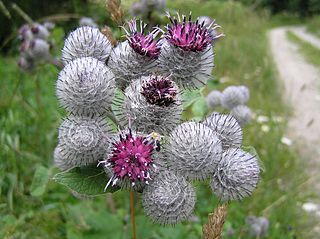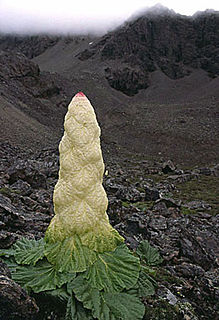
Rhubarb is the fleshy, edible stalks (petioles) of species and hybrids of Rheum in the family Polygonaceae, which are cooked and used for food. The whole plant – a herbaceous perennial growing from short, thick rhizomes – is also called rhubarb. Historically, different plants have been called "rhubarb" in English. The large, triangular leaves contain high levels of oxalic acid and anthrone glycosides, making them inedible. The small flowers are grouped in large compound leafy greenish-white to rose-red inflorescences.

A Prairie Home Companion is a weekly radio variety show created and hosted by Garrison Keillor that aired live from 1974 to 2016. In 2016, musician Chris Thile took over as host, and the successor show was eventually renamed Live from Here and ran until 2020. A Prairie Home Companion aired on Saturdays from the Fitzgerald Theater in Saint Paul, Minnesota; it was also frequently heard on tours to New York City and other U.S. cities. The show is known for its musical guests, especially folk and traditional musicians, tongue-in-cheek radio drama, and relaxed humor. Keillor's wry storytelling segment, "News from Lake Wobegon," was the show's best-known feature during his long tenure.

Lester William Polsfuss, known as Les Paul, was an American jazz, country, and blues guitarist, songwriter, luthier, and inventor. He was one of the pioneers of the solid-body electric guitar, and his prototype, called the Log, served as inspiration for the Gibson Les Paul. Paul taught himself how to play guitar, and while he is mainly known for jazz and popular music, he had an early career in country music. In the 1950s, he and his wife, singer and guitarist Mary Ford, recorded numerous records, selling millions of copies.

Arctium is a genus of biennial plants commonly known as burdock, family Asteraceae. Native to Europe and Asia, several species have been widely introduced worldwide. Burdock's clinging properties, in addition to thus providing an excellent mechanism for seed dispersal, led to the invention of the hook and loop fastener.
In American radio, film, television, and video games, walla is a sound effect imitating the murmur of a crowd in the background. A group of actors brought together in the post-production stage of film production to create this murmur is known as a walla group. According to one story, walla received its name during the early days of radio, when it was discovered that having several people repeat the sound walla in the background was sufficient to mimic the indistinct chatter of a crowd. Nowadays, walla actors make use of real words and conversations, often improvised, tailored to the languages, speech patterns, and accents that might be expected of the crowd to be mimicked.

The Rhubarb Triangle is a 9-square-mile (23 km2) area of West Yorkshire, England between Wakefield, Morley and Rothwell famous for producing early forced rhubarb. It includes Kirkhamgate, East Ardsley, Stanley, Lofthouse and Carlton. The Rhubarb Triangle was originally much bigger, covering an area between Leeds, Bradford and Wakefield. From the 1900s to 1930s, the rhubarb industry expanded and at its peak covered an area of about 30 square miles (78 km2).

Rheum palmatum is a species of flowering plant in the knotweed family Polygonaceae. It is commonly called Chinese rhubarb, ornamental rhubarb, Turkey rhubarb or East Indian rhubarb.
Chinese rhubarb can mean either of two species of rhubarb, genus Rheum:

Rheum nobile, the Sikkim rhubarb or noble rhubarb or पदमचाल, is a giant herbaceous plant native to the Himalaya, from northeastern Afghanistan, east through northern Pakistan and India, Nepal, Sikkim, Bhutan, and Tibet to Myanmar, occurring in the alpine zone at 4000–4800 m altitude.

Rheum is a genus of about 60 herbaceous perennial plants in the family Polygonaceae. Species are native to eastern Europe, southern and eastern temperate Asia, with a few reaching into northern tropical Asia. Rheum is cultivated in Europe and North America. The genus includes the vegetable rhubarb. The species have large somewhat triangular shaped leaves with long, fleshy petioles. The flowers are small, greenish-white to rose-red, and grouped in large compound leafy inflorescences. A number of cultivars of rhubarb have been domesticated both as medicinal plants and for human consumption. While the leaves are slightly toxic, the stalks are used in pies and other foods for their tart flavor.

Rheum officinale, the Chinese rhubarb, or Indian rhubarb is a rhubarb from the family Polygonaceae native to China. In Chinese it is called yào yòng dà huáng, literally meaning medicinal rhubarb.

In botany, the petiole is the stalk that attaches the leaf blade to the stem, and is able to twist the leaf to face the sun. This gives a characteristic foliage arrangement to the plant. Outgrowths appearing on each side of the petiole in some species are called stipules. Leaves with a petiole are said to be petiolate, while leaves lacking a petiole are called sessile or apetiolate.

Rheum rhabarbarum is a species of flowering plant in the family Polygonaceae, native to southern Siberia to north and central China. It has been harvested from the wild for centuries for its root, which was harvested for use as a popular medicine in Europe and Asia. It was later cultivated for its root in England and Russia. It is considered to be one of the species involved in the development of culinary rhubarb, for which the scientific name R. rhabarbarum is sometimes (erroneously) used.

Rhubarb pie is a pie with a rhubarb filling. Popular in the UK, where rhubarb has been cultivated since the 1600s, and the leaf stalks eaten since the 1700s. Besides diced rhubarb, it almost always contains a large amount of sugar to balance the intense tartness of the plant. A strawberry rhubarb pie is a type of tart and sweet pie made with a strawberry and rhubarb filling. Sometimes tapioca is also used. The pie is usually prepared with a bottom pie crust and a variety of styles of upper crust. In the United States, often a lattice-style upper crust is used. This pie is a traditional dessert in the United States. It is part of New England cuisine. Rhubarb has long been a popular choice for pies in the Great Plains region and the Midwest Region, where fruits were not always readily available. Rhubarb pies and desserts are popular in Canada as well, as the rhubarb plant can survive in cold climates.

Rheum australe, synonym Rheum emodi, is a flowering plant in the family Polygonaceae. It is commonly known as Himalayan rhubarb, Indian rhubarb and Red-veined pie plant. It is a medicinal herb used in the Indian Unani system of medicine, and formerly in the European system of medicine where it was traded as Indian rhubarb. The plant is found in the sub-alpine and alpine Himalayas at an altitude of 4000 m.

Rheum maximowiczii is a large herbaceous perennial plant species in the genus Rheum (rhubarbs) from the mountains of Central Asia where it grows in Kazakhstan, eastern Uzbekistan, Tajikistan, Kyrgyzstan and northeastern Afghanistan.

Rheum ribes, the Syrian rhubarb or currant-fruited rhubarb, or warty-leaved rhubarb, is an edible wild rhubarb species in the genus Rheum. It grows between 1000 and 4000 m on dunite rocks, among stones and slopes, and is now distributed in the temperate and subtropical regions of the world, chiefly in Western Asia to Afghanistan and Pakistan and also in ladakh(Kargil) region of India. The Syrian rhubarb is a partially commercial vegetable collected from the nature in Eastern and Southern Anatolia, Northern Iraq and partly Northwestern Iran in early spring. Rheum ribes is considered as a valuable medicinal species in herbal medicine.

Rheum rhaponticum, the false rhubarb, rhapontic rhubarb or rhapontic, is a plant species in the genus Rheum found in the wild. It is the only Rheum species found only in Europe, and is now restricted to the Rila mountain range in south-western Bulgaria. It was introduced to other countries in Europe. It is considered to be one of the parents of the modern culinary rhubarb.
Agnia Sergeyevna Losina-Losinskaja (1903–1958) was a Soviet botanist. Her family name is also transcribed as Lozina-Lozinscaia, and Lozina-Lozinskaja.
Rheum lhasaense is a plant from eastern Tibet belonging to the genus Rheum in family Polygonaceae. It is a mid-sized rhubarb species with triangular leaves and spherical fruit.














